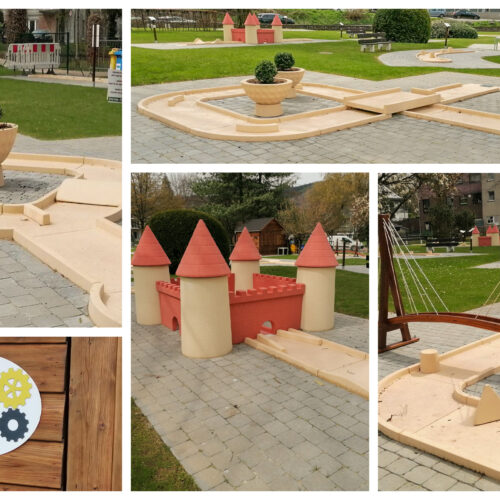564th Malmedy carnival 2025
An age-old tradition
Malmedy’s Cwarmê is been celebrated for centuries: an archival document dating back to 25 June 1459 refers to the Monday and Tuesday of the “Quarmae”, thus suggesting that the Cwarmê (dialect for Malmedian Carnival) was being celebrated as early as that date and possibly even a lot earlier. In Malmedy, the word “Cwarmê ” refers to the carnival period that lasts for four days, from Saturday at noon to midnight on the day of Mardi Gras (Shrove Tuesday).
The four days are also called the “grandès-haguètes” in contrast to the “p’titès haguètes“, which are the four Thursdays, or Shrove Thursdays, preceding the Cwarmê. These Thursdays were regarded as masquerade days as early as 1666, as underscored by the story told about a fatal accident on Tuesday, 24 February, when a young girl’s linen mask caught fire. The unfortunate young lady was presumably getting herself ready for the following Thursday…
The first ban on celebrating the carnival was announced in 1695, during the reign of the prince abbots. Several other bans were issued during the 18th century. However, the people of Malmedy had other ideas and disregarded the prohibitions.
It is hard now to imagine what the festivities were like in those far-off times but the official creation of organized associations has facilitated the discovery of many traces of the 19th century carnival celebrations, which very similar to the present-day ones.
During the 20th century, bans were imposed only during wartime and in 1962, owing to the risk of infection during a smallpox epidemic.
The dogged spirit of the Malmedy inhabitants has guaranteed this astonishing continuity of the Cwarmê tradition.
Carnival of Malmedy.
The traditional carnival figures
Russian salad
Unique, exclusive to Malmedy, a must… Every festivity is accompanied by a real feast! Shrovetide came before Lent, when abstention was almost obligatory once up a time as the winters months dragged on. Food supplies were soon exhausted, as the procedures people used to keep food from spoiling were fairly rudimentary. Salting and smoking techniques were used for meat, while one of the few types of fish that reached this part of the world were herrings pickled in brine. Vegetables tended to be the sort that were easy to preserve in a cellar or storeroom: potatoes, beetroots, onions, celeriac, pickled gherkins, apples and even walnuts. Luckily the hens would keep on laying eggs.
It was a problem deciding what kind of dishes to make with these food items. Then someone came up with the idea of mixing these ingredients to make an odd kind of “salad” that was so unusual that people started to say it was kind of “Russian”, as though it came from Nowhereland! Every family added its own personal touch, seasoning the dish according to taste. A unique dish that could be prepared in advance so the lady of the house did not have worry about what to cook for the festivities! It can be eaten cold: alone, with friends, anytime night and day, and is great for alleviating hunger pangs and lifting the spirits!
Recipe using 6 herrings
The proportions are a bit vague but that should not be a problem as a long as you keep a watchful eye out! And after all, it would not do to reveal all the secrets about how to make this splendid dish. It is best to leave something to your imagination?
6 nice and firm herrings, 1 large glass of red beetroots (garden-fresh if possible) with the juice, 1 celeriac, 3 healthy looking onions, 1 dish of potatoes, 1 fine-looking apple, 6 hard-boiled eggs, 750 g of boiled beef, 500 of roast pork, 1 cup of oil, 1 glass of white pickled onions, 1 glass of gherkins, and you can also add one or two walnuts if you want.
- prepare a nice vegetable stock (carrots, celery, potatoes, leeks, mixed herbs…) to cook the beef until it is tender,
- roast the piece of pork in a pan according to taste,
- cook the peeled potatoes, celery and eggs,
- let everything cool off,
- chop the drained onions and gherkins, apple, cooked celery, half the beetroots, the vinegar-seasoned onions with herrings and crush the walnut kernels,
- slice finely the two kinds of meat, the herrings from which the bones have been removed, the rest of the beetroots, the hard-boiled eggs and potatoes,
- keep for garnishing the dishes: slices of hard-boiled eggs and beetroots, small onions and gherkins,
- mix everything in a basin, season with salt and pepper to taste,
- add the beetroots to give some colour,
- • cover with a cloth and leave the preparation for one or two days in a cool place.
Place the Russian salad in the dishes, garnishing it with the hard-boiled eggs, onions, gherkins sliced in two lengthways …
The meal can be eaten accompanied with slices of udder (do pé) or chitterling (dol landouye), traditional stuffed cow’s stomach.















































